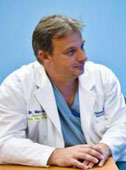Advancing the Science of Burn Care

Marc Jeschke consults
with a remote burn
patient via the wonders
of telemedicine
|
Hypertrophic scarring in
burn patients is a problem
that is treated with
pressure garments worn
for as long as two years.
They are measured and
refitted every three to
four months. Massage is
also used up six or seven
times a day by physiotherapists.
Marc Jeschke
uses stem cells from
abdominal fat obtained
by liposuction to reduce scarring. He also uses silicone
sheets, lasers, cortisone injections and topical cortisone
applications, as well as 5 FU to reduce scarring. He showed
me pictures of a patient severely deformed by keloid formation
over the face who was treated by radical excision,
advancement of skin flaps and injection of stem cells into
the wound. The stem cells follow epigenetic factors in the
surrounding tissues to differentiate into the appropriate cell
line. The cosmetic result was excellent.
|
In 1994, Marc Jeschke completed medical school and
his thesis summa cum laude in Tubingen, Germany.
He completed a research Fellowship from 1996-
1999 with the University Texas Medical Branch
and Shriners Hospital for Children. During this
time he completed his Masters of Medical Science.
He returned to Germany, to the Department of
Surgery at the University of Regensburg where
received his surgical training and was awarded the
habilitation (PhD) in Experimental Surgery in
2001. He returned to the University Texas Medical
Branch and Shriners Hospital for Children in 2004
as Attending Surgeon and Coordinator of Research.
Furthering his interest in burn and critical care,
Marc undertook a clinical fellowship rom August
2005 to June 2006 as the Burn and Critical Care
Fellow at the University Texas Medical Branch and
Shriners Hospital for Children, the only program
to be certified by ACMG.
In May 2010, Marc was appointed Director of the
Ross Tilley Burn Centre at Sunnybrook Health
Science Centre and Surgeon -Scientist in the Division
of Plastic and Reconstructive Surgery.
Marc has been caring for burn patients and conducting
research in the field of burns for nearly
20 years and in that time has published more
than 180 peer-reviewed articles and has authored
several books and chapters on burn care. He was
continuously funded as the Principal Investigator
since 2000 from the German Research Council,
the National Institutes of Health, and Shriners
Hospital for Children Foundation.
He has mentored and trained more than 40 PhD,
MD, and other graduate students in the field of burn
care and burn-related research.
|
|
The Ross Tilley Burn Centre has its own operating
room and strong support from Sunnybrook Health
Sciences Centre, but the novel legislative requirement
that every burn in the province can be admitted to a
burn centre results in a lot of patients needing primary
burn operations. "It is hard to do reconstructive or other
cases when you are treating so many burns." Marc and
his team collect tissue for research from every operation
under REB approval.
ROSS TILLEY BURN CENTRE RECEIVES ABS CERTIFICATION
The Ross Tilley Burn Centre, Division of Plastic and
Reconstructive Surgery at the Sunnybrook Health
Sciences Centre has been certified as an adult burn
centre after a site visit in June 2011. Toronto now
becomes the sole designated certified burn centre
sanctioned by the American Board of Surgery in all of
Canada. Special thanks to Marc Jeschke and his team
for this accomplishment.
|
Marc has three main research foci. One is to create
skinfrom umbilical cord and amniotic membrane
cells. The research team includes laboratory staff and
an engineer. "The most difficult part of this quest is
getting the matrix for the cells. Integra, a commercial
matrix material based on John Burke’s work in Boston
is a silicone bandage on bovine collagen. Integra is an
excellent bioengineered device that helps burn surgeons
treat delicate areas, but it is extremely expensive. At
RTBC we use it for the face and hands, but we cannot
justify the expense to use it on extensive body burns. The
silicone is peeled off after the Integra bandage has been
applied for 2-3 weeks and a thin autograft is applied to
the Integra base."
The second research theme examines the effect of
stress on the endoplasmic reticulum and mitochondria
using a human liver model. A paper on this work is in
press in the Annals of Surgery. The third theme is treatment
of insulin resistance. It is unclear whether it is glucose
or other factors such as catecholamines induced by
glucose that cause resistance. Marc is studying the use of
insulin and metformin effects on tissues and on infection
with his colleagues Alison Cheung, PhD clinical research
manager, and Rachael Harrison, PhD, lab manager. He
has not yet had surgeon-scientists in the program, but
has two current fellows, one from Spain and one from
Bahrain, and several PhD and Masters" Degree students.
M.M.
|